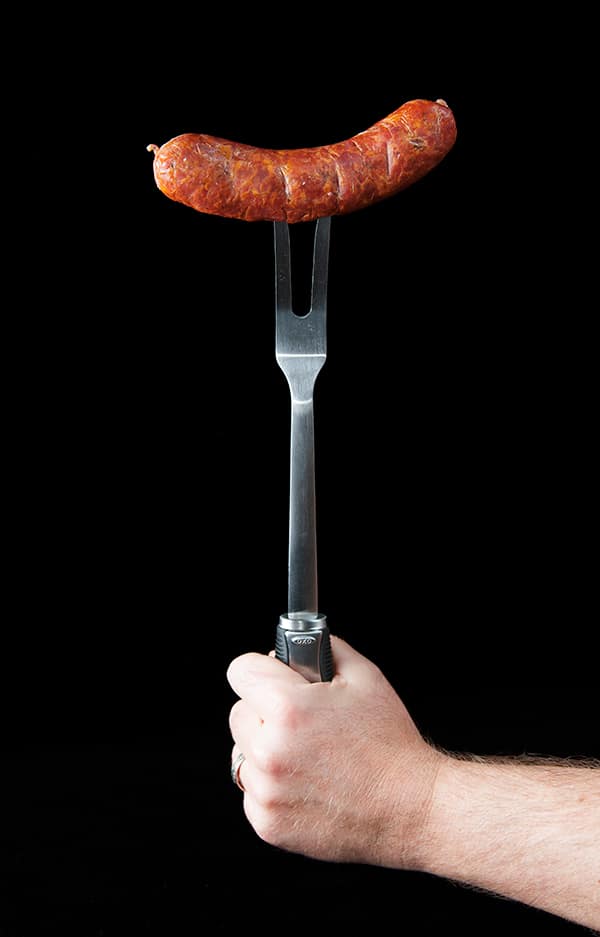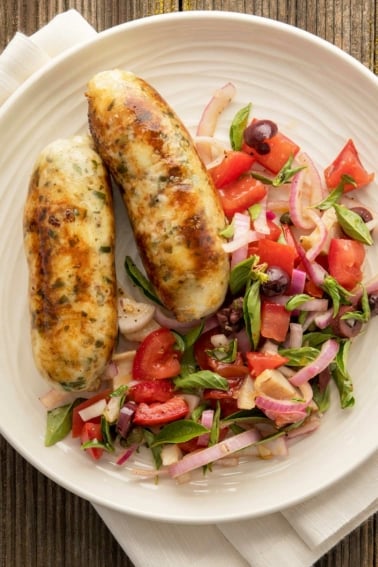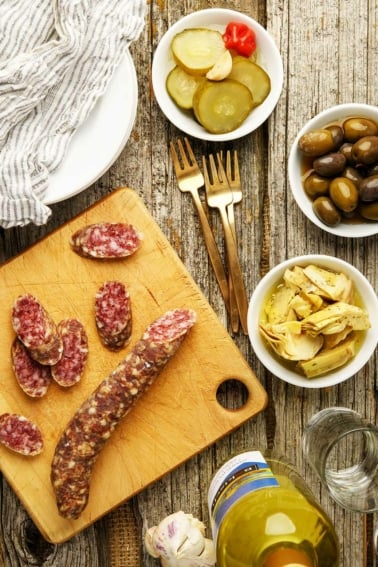As an Amazon Associate I earn from qualifying purchases.

Linguica. It’s part of the culinary fabric of California’s great Central Valley, available at every greasy spoon from Redding to Bakersfield, served at breakfast, lunch and dinner. You can thank the Azoreans for this one.
I’ve heard tell that there are more Azoreans in California than there are in the Azores, which, if you are not familiar, are a small chain of islands off the coast of Portugal. You can see their names everywhere around here: Silva, Lopes, Mendes, Machado, Costa, Cardoza. Linguica eaters, all.
What is this strange sausage of which I speak? Linguica (Ling-GWEE-zuh) is a pork sausage heavily spiced with paprika, chiles and garlic. There are all sorts of variations, but linguica is normally a coarse, country sausage, and it is often smoked. I’ve eaten linguica all over the country, but the best have been in Gloucester, Massachusetts (where my mother and sister live), and here in the Valley.
A really good linguica, to my mind, is a cudgel of a sausage. Smoky, garlicky and rich with pork fat and red peppers, it is spectacular served with grilled onions on a hoagie roll. A man’s sandwich.
The Portuguese put linguica in almost everything, but in addition to sandwiches, I love it in soups with Portuguese cabbage (which is a lot like our collard greens) and potatoes. My friend David Leite has several good recipes using linguica in his cookbook The New Portuguese Table.
I made my version with wild pig. Of course if you can’t get wild boar, you can use pork. But use good-quality pork from a good butcher or a farmer’s market. I suppose you could also use bear, too, if you have that lying around.
If you’ve never made sausage before, start by reading this detailed tutorial on how to make sausages at home.
Portuguese Linguica
Ingredients
- 3 1/2 pounds pork shoulder or wild boar meat
- 1 1/2 pounds pork fat
- 34 grams kosher salt
- 6 grams Instacure No. 1 (optional)
- 1 tablespoon dextrose or white sugar
- 10 garlic cloves, minced
- 1 tablespoon sweet paprika
- 1 teaspoon hot paprika or cayenne
- 1 teaspoon smoked paprika (optional)
- 1 tablespoon dried oregano
- 1 tablespoon crushed black pepper
- 1/2 cup dry milk (optional - it helps the sausage retain moisture while smoking)
- 3/4 cup red wine, preferably a Portuguese wine
- Hog casings
Instructions
- Chill the meat and fat until they're almost frozen by putting it in the freezer for an hour or so.
- Take out some hog casings -- you'll need about 3 to 4 standard lengths, about 15 feet -- and set in a bowl of very warm water.
- Chop meat and fat into chunks that will fit into your grinder. Combine the salt, instacure (if using), sugar, garlic, dry milk and the rest of the spices and mix it into the meat and fat with your hands. Let this rest in the fridge for about an hour. (Optional expert step: Mix the chunks of meat and fat with the salt and curing salt overnight before proceeding. Doing this will give you a better bind on the sausage.)
- Grind through your meat grinder using the coarse die, about 6.5 mm or so. If your room is warmer than 69°F, set the bowl for the ground meat into another bowl of ice to keep it cold. Put the mixture back in the freezer while you clean up.
- Add the wine to the meat mix, then mix thoroughly either using a Kitchenaid on low for 60-90 seconds or with your (very clean) hands. This is important to get the sausage to bind properly. Once it is mixed well, put it back in the fridge while you clean up again.
- Stuff the sausage into the casings. Do whole coils before making links. Twist off links by pinching the sausage down and twisting it, first in one direction, and then with the next link, the other direction. (Here's a quick video on making the links) Or you could tie them off with butcher’s string.
- Hang the sausages in a cool place. If it is warm out or if you are smoking your links, hang for one hour. If you have a place where the temperature will not go higher than 38°F, you can hang them as long as overnight.
- If you are smoking your sausages, get your smoker going while the sausages hang. Smoke the links for at least 3 hours, and as many as 12. I prefer a lighter smoke, so you can still taste the pork and spices. I prefer oak, but hickory, maple, pecan or a fruit wood would also work.
- Once the sausages have dried and/or smoked, put them the fridge until needed. If you are freezing the sausages, wait a day before doing so. This will tighten up the sausages and help them keep their shape in the deep-freeze.
Notes
Nutrition
Nutrition information is automatically calculated, so should only be used as an approximation.





Hi Hank. Tried your andouille and the linguica sausage recipes. Liked them both. Never made them before. I did 10 lbs. of each out of my muley buck and pork butts, The only thing is the salt intake needs to be decreased to about 4 tablespoons for 10 lbs. otherwise nice recipe. I have made a lot of sausages, pepperoni, jerky and bacon. Salt is a tricky thing to work with. Adding insta cure (sodium nitrite) is a sodium product that also adds to the sodium levels. Will tweak the salt levels down next time. Otherwise good job. Thumbs up. Thank you !!!!
Was very interested in your recipe for Linguica I do think it would be helpful to include target temp this sausage needs to reach while smoking so it’s not over cooked or turns out dry.
Ray: I never test internal temp of sausages, because, well, I’ve been doing it for a long time. But 155F is a good marker. Nothing more than 165F.
I am from southeast MA, which has a large Portuguese population. I grew up with linguica and absolutely love it. I now live in VA, where linguica is non-existent. I miss it terribly. ?
Was looking for a good recipe and was thrilled to see its from someone from my home town of Gloucester MA.
Can’t wait to try this tomorrow!
Hank, I just made a batch of these sausages out of a 75/25 mixture of wild boar and pork back fat. I followed the recipe very closely, but the resulting fresh sausages did not have the red coloring that I expected, being more of a standard grey. Can I assume that the addition of more paprika is the solution, or will it develop the traditional color solely as a result of the smoking process? I thought about adding more paprika during the binding process, but was afraid of overpowering the flavor of the pork.
Richard: Yes, the color comes in the smoking process.
I notice that you do only one grind (6.5 mm die) for this sausage, while the recipe in the tutorial you link to does two grinds (10 mm die). Is that because this sausage is intended to be coarser than other sausages, or is it just personal taste?
Richard: This is an older recipe. If I were to make it today, I would do the double grind, 10 mm and then 6.5 mm or so. It is a coarse sausage, though.
Hank,
Thank you for making this website and for keeping it up. I discovered your website during the pandemic while looking for some new recipes. Your site has not disappointed. I have found your site as my go to when wanting to make sausage. Sometimes I may deviate but you get me headed into the rite direction.
Today I made the Portuguese Linguisa (again) and it really rocks.
Kind Regards,
Robert
Can you skip putting these into the casings and making patties?
Kyia: Yes you can.
A note when cooking linguica patties:
I have found that frying them quickly is a better way to keep them moist. I love grilled linguica like any good Portagee but on the grill they tend to dry out.
Can I substitute buttermilk powder for the milk powder?
Mike: I don’t know, actually. It’s quite acidic, and I know high acidity can break the bind in a sausage. I wouldn’t use it because of that. You can skip it altogether, just don’t let the sausages stay too long once they hit an internal temperature of 155F to 160F, then submerge them all in a tub of ice water immediately out of the smoker.
If you warm smoke the sausage how hot should your smoker be set too.
Mike: Not very hot, about 225F or even a little lower.